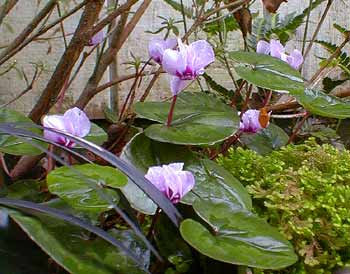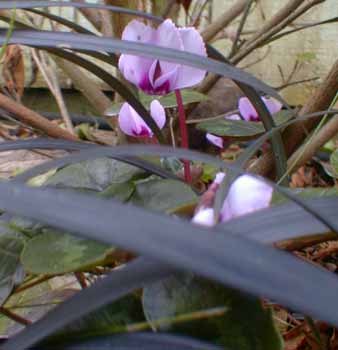 Shell Pink
Shell Pink
Winter Cyclamen
"I have an insatiable desire for Cyclamens, & could never have too many, for I know of no other plant that will turn patches of dust under thick trees into stretches of beauty so permanently & thoroughly."
-A. E. Bowles,
My Garden in Autumn & Winter,
1915
My Garden in Autumn & Winter,
1915
C. coum is native to the Black Sea region down to the eastern Mediterranean & as far into the Near East as Israel. It grows in deep forest shade often right up against a tree. An old patch clumps to a twelve inch spread of rounded mottled leaves mid-autumn through early spring, with the height of their bloom in winter.
We have a great many patches of C. coum. The first ones we ever planted were started from seedlings obtained from Heronswood Nursery. The first they labeled 'Shell Pink.' It is is pale violet-pink with touches of white. The March photo above shows its blooms above the faintly tree-patterned leaves under the Azalea twigs, with Golden Club Moss competing for space, & a few black leaves of Mondo Grass poking into the frame. The second photo shows the same plant a year later, in February.
 Heronswood had periodically carried what appears to be the full line of cyclamens from Ashwood Nursery in England. From these more recent offerings we obtained a few rarely offered species, plus other C. coum varieties, including evenly pewtered varieties 'Tilebarn Elizabeth,' & the clumsily named but beautiful 'BSBE 518.' Others get added each year since I for one can't resist a leaf that seems a bit different from others already spread about our gardens.
Heronswood had periodically carried what appears to be the full line of cyclamens from Ashwood Nursery in England. From these more recent offerings we obtained a few rarely offered species, plus other C. coum varieties, including evenly pewtered varieties 'Tilebarn Elizabeth,' & the clumsily named but beautiful 'BSBE 518.' Others get added each year since I for one can't resist a leaf that seems a bit different from others already spread about our gardens.Ashwood has named certain cyclamens 'Shell,' 'Rose' & 'Magenta' to indicate a progression of color intensity. Such names designate color variations rather than registered cultivars. Leaf variety would be the next defining feature. This one is Patternleaf but the pattern is rather faded.
Both 'Shell' & 'Rose' have appeared in catalogs in England & America described as having "variously mottled" leaves, but the mottling is not a high point on either of our specimens, & the most strikingly marked varieties are usually grouped under headings like 'Silverleaf.' The simpler leaves of our 'Shell' with its extremely faint arrowhead pattern framed with yellowish-green, & the almost plain but thinly white-freckled 'Rose Pink,' are very lovely, but many other strains of C. coum are much more extreme in their patterning (such as for example 'White-silver Pattern-leaf Pink').
'Shell Pink' like most C. coums leafs out in October & is very leafy indeed by the time it blooms in January, & continues to be increasingly leafy & flowery up through March. When it is finished flowering, the leaves last longer into spring (April). By comparison the nearby 'Rose Pinks' has very few leaves when it produces many wirey, twining, creeper-like flower stems. It flowers robustly late January through March, but holds back its full production of leaves until March, which isn't typical of the species but is how this one clump has behaved every year.
Cyclamens can live pretty much forever; or, at least, their lifespan is as long as many trees, with the tuber very slowly growing larger with each decade until it can become as big as a kid's head, though flattened.
They require little or no fertilizing. If it is inescapable that they get some fertilizer while taking care of heavier feeders in the vicinity, they may get leafier, but not flowerier. They will do much better if fed nothing other than wholesome, fine, dark compost or leafmold as a thin top-dressing, perhaps even sieved to avoid compost chunks that might retard new growth of tender young leaves & the coiling stems of flowers. This would apply to any of the hardy outdoor species, not just C. coum.
C. coum self-seeds with abandon & will colonize an area after a few years, faster than any other hardy cyclamen, with little seedlings even popping up in pots of nearby containered plants. It is by no means necessary that a tuber be well developed before they leaf & bloom. Seedlings of most other species will take on average three years to be flowery when started from seed, with pleasant leaves in the meantime; but self-seeded C. coum sometimes blooms at the end of its very first year, & inevitably by the second.
Continue to
Cyclamen coum 'Rose Pink'